Author Archive
Following is an excerpt from a blog entry of Professor Giridhar Madras of IISc Bangalore.
… According to the table, for an assistant professor on contract i.e., with no postdoc experience, it would start at 37,000 + accommodation. A regular assistant professor will get 52,000 + accommodation and will move to 62,000 + accommodation after three years. In addition, they are other benefits. This includes telephone allowance, academic allowances, children education allowance, subsidy for single girl child, leave travel concession for the whole family every year,medical benefits to the family, travel money for attending conferences etc.
In addition, one can get fellowships that vary from Rs 60,000 to Rs 6 lakhs per year from DST/DBT, depending on the fellowships. Faculty can go abroad during the three month vacation every year and get paid in international currency. One can take sabbatical for one year every six years and get paid at both places. In addition, one can earn considerably from consultancy from industry (or even government labs) depending on the area they work in.
The blog has more details and pointers to more details on what the IIXs should do to get a clearer picture out to prospective faculty.
September 27th, 2009
Following is an excerpt from a press release by Orissa’s Resident Commissioner in New Delhi.
He suggested to establish ‘National Research Institute for Management of Wetlands and Coastal Ecosystems’ at Chilika as there is no dedicated research centre in this environmentally important subject. Chief Minister pointed out that the infrastructure created at Chandraput and the expertise available with Chilika Development Authority (CDA) could be extremely useful in starting such a national institute. The Union Minister welcomed the proposal and asked the Ministry officials to jointly work with the State government officials to formulate the plan.
Chief Minister also highlighted the need for a National Mangrove Research Institute in Orissa and mangroves along the coast help in preventing the damage brought by tsunami, cyclones and super cyclones. The National Mangrove Research Center could also monitor the impact of the sea level rise, cyclone associated tidal surges and other anthropogenic pressures on mangroves, he suggested.
September 26th, 2009
The March 28th 2008 PIB mentioned a central university and an IIM for J & K. But the Jammu and Kashmir valley area both wanted a central university. The solution that MHRD came up with is as described in the following PIB release.
In view of the special status of State of Jammu and Kashmir, which has separate regions with distinct geographical, social, cultural and ethnic characteristics, the Central Government has decided to establish, as a special dispensation, two appropriate Central Universities in the State – one in Jammu region and another in the Kashmir Valley. It is expected that this will meet the regional aspirations in the State. The Government proposes to undertake appropriate legislative measures in this regard shortly.
The two Central Universities will have instructional and research facilities in emerging branches of learning like information technology, biotechnology, nanosciences, etc., setting exemplary standards of education for the other universities in the State to emulate.
However, in view of the constraints of resources and greater demand for a second Central University in Jammu and Kashmir State, it has been decided to drop the proposal for the establishment of an Indian Institute of Management in Jammu and Kashmir and instead use the savings for the establishment of a second appropriate Central University in the State of Jammu and Kashmir.
Budgetwise a central university (at 300 crores) is about 40% more expensive than an IIM (at about 210 crores).
Since Goa university opted out of becoming a central university and a new IIM was added to Rajasthan, the total number of new IIMs and Central Universities remains the same as announced in the March 28th PIB. (Of course, for now, Goa will not have a central university. Rajasthan was a lucky gainer because of a typo in the finance minister’s announcement. But they are delaying things by not adhering to MHRD hints with respect to their IIT location.)
A similar action that MHRD took was to reduce its number of new NITs to 9 so as to accommodate the proposed ABA Ghani Khan Choudhury Institute of Engineering & Technology.
It seems MHRD is taking great pains to keep its budget and number of institutions as decided during the 11th plan deliberations. Perhaps because of that Orissa CM did not pursue an IGNTU campus with MHRD and raised the issue of a tribal university with the Minister of Tribal affairs. I think one has to wait till the 12th plan for any new additions (beyond what is mentioned in the 11th plan) regarding central institutions through MHRD. (There may be more flexibility in other ministries. For example, the AIIMS-like institutions budgets have been increasing. But by the time they start running the 12th plan period will be on.)
This means if Orissa wants an IIM before the 12th plan, it has to go after an existing IIM and make a deal with them, similar to what Andhra Pradesh did with IIM Ahmedabad.
September 25th, 2009
Following is an excerpt from a press release of Orissa’s Resident Commissioner in Delhi.
New Delhi
September 24, 2009
Chief Minister meets Union Minister for Tribal Affairs
Shri Naveen Patnaik, Chief Minister, Orissa met Shri Kanti Lal Bhuria, Union Minister for Tribal Affairs at New Delhi today and discussed about issues relating to tribal welfare in Orissa.
…
The Chief Minister also asked for release of Rs.140 crores during 2009-2010 for construction of 400 new 100 bedded ST Girls Hostels in the State. The Chief Minister requested that a Tribal University be set up in the Kondhamal district in Orissa. The Chief Minister requested for grant of Rs 5 crores for modernisation of the existing small Tribal Museum at Bhubaneswar and separate fund for opening of Tribal Museums in all the 17 Micro Project Areas in the State. He highlighted the need for increase in the amount of Post Matric Scholarship for ST/SC Students.
Recalling his recent letter written to the Union Minister, the Chief Minister asked for sanction of more Ekalabya Model Residential Schools (EMRS) in the 4 uncovered KBK districts i.e., Nuapada, Malkangiri, Sonepur & Bolangir in the current academic session.
September 25th, 2009
Finally someone comes out and openly writes in favour of Vedanta University in the local papers. Its high time someone did that.
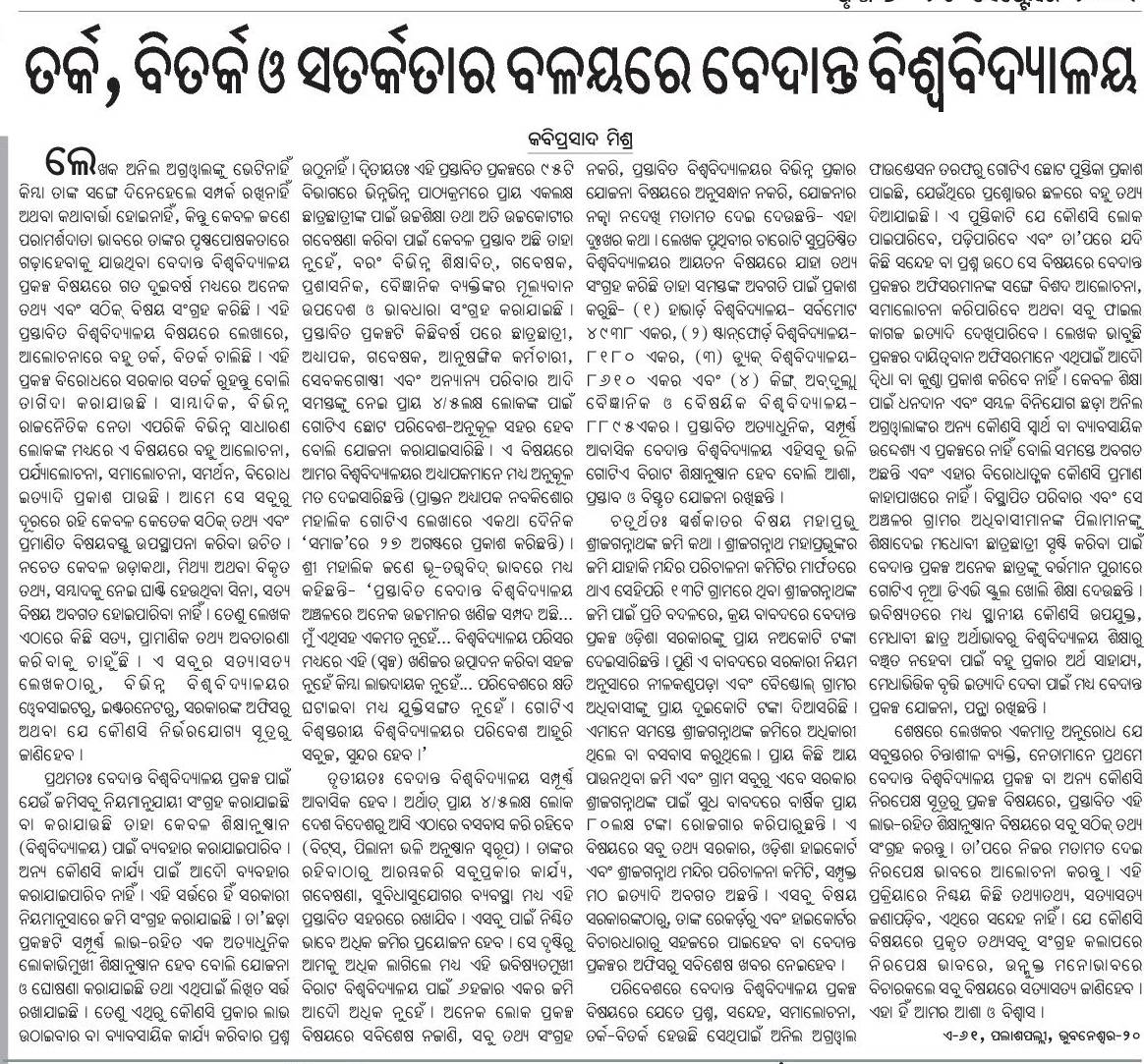
Given below is the article by retired Utkal University Professor Nabakishore Mahalik on August 27th that the above writer mentions.
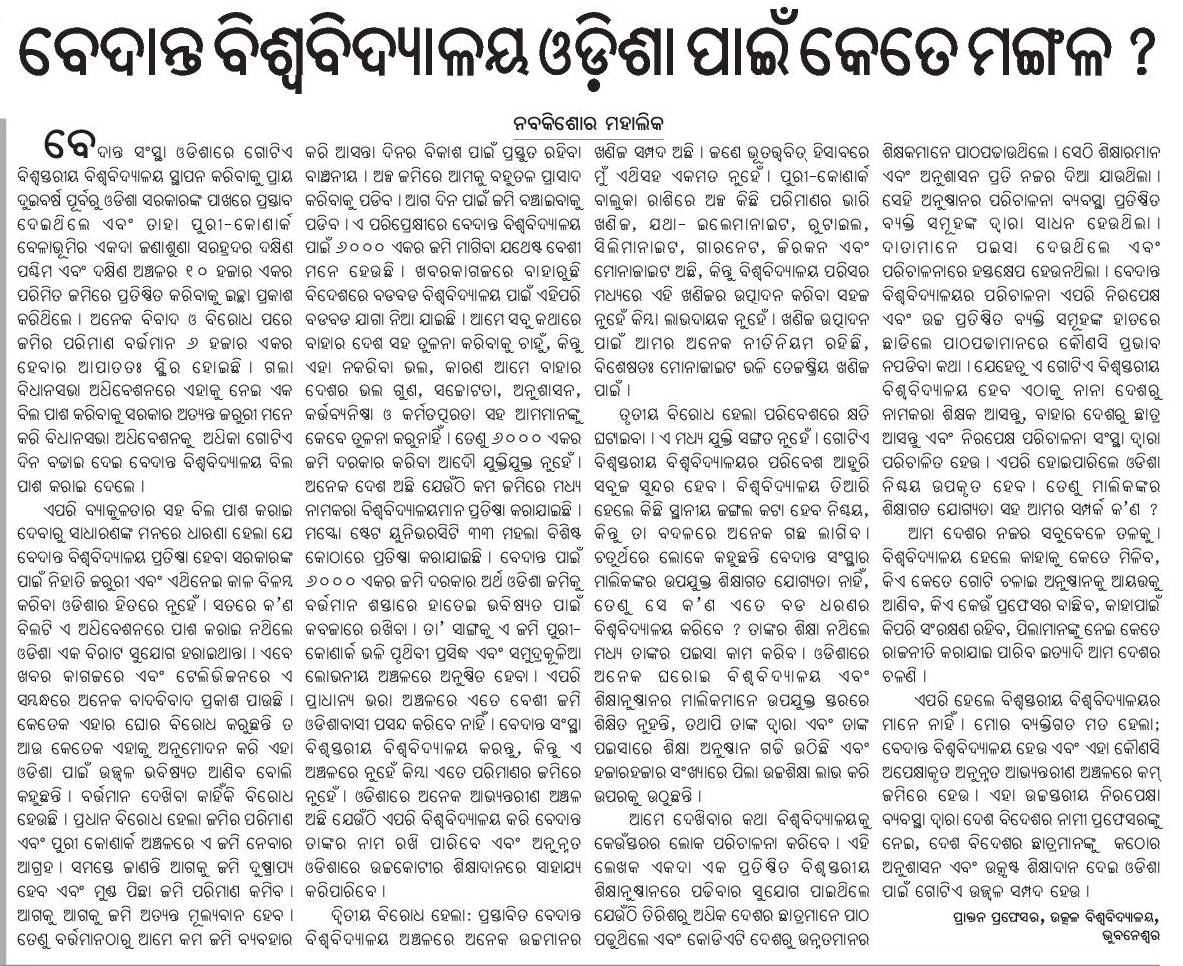
September 24th, 2009
Thanks to tathya.in for the pointer. The Department of Higher Education web page is at http://www.dheorissa.in/DHE/Scholarship_Schemes.aspx. Following links are from that web page.
Scholarship Schemes of State & Central Government for 2009-10
The image of the advertisement is given below.

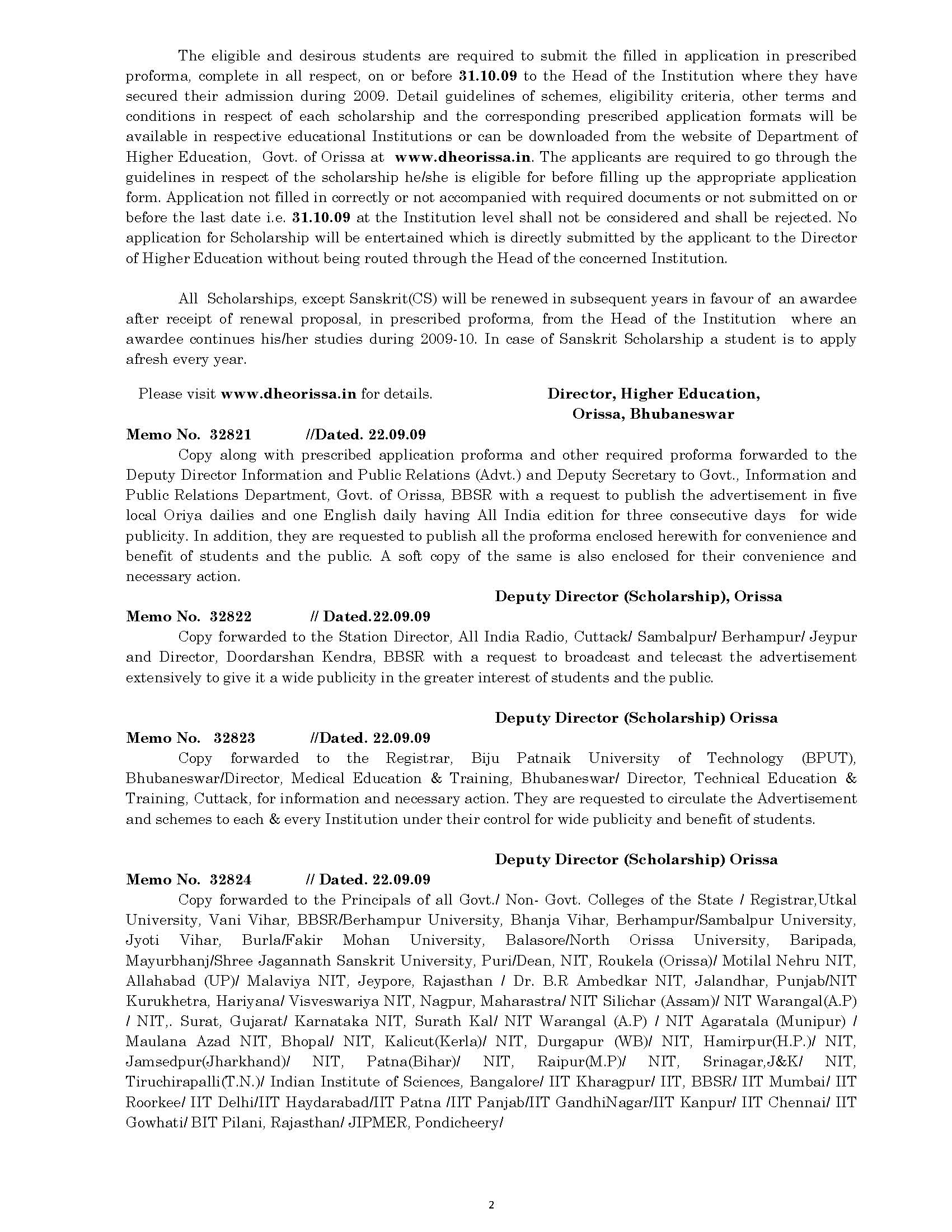
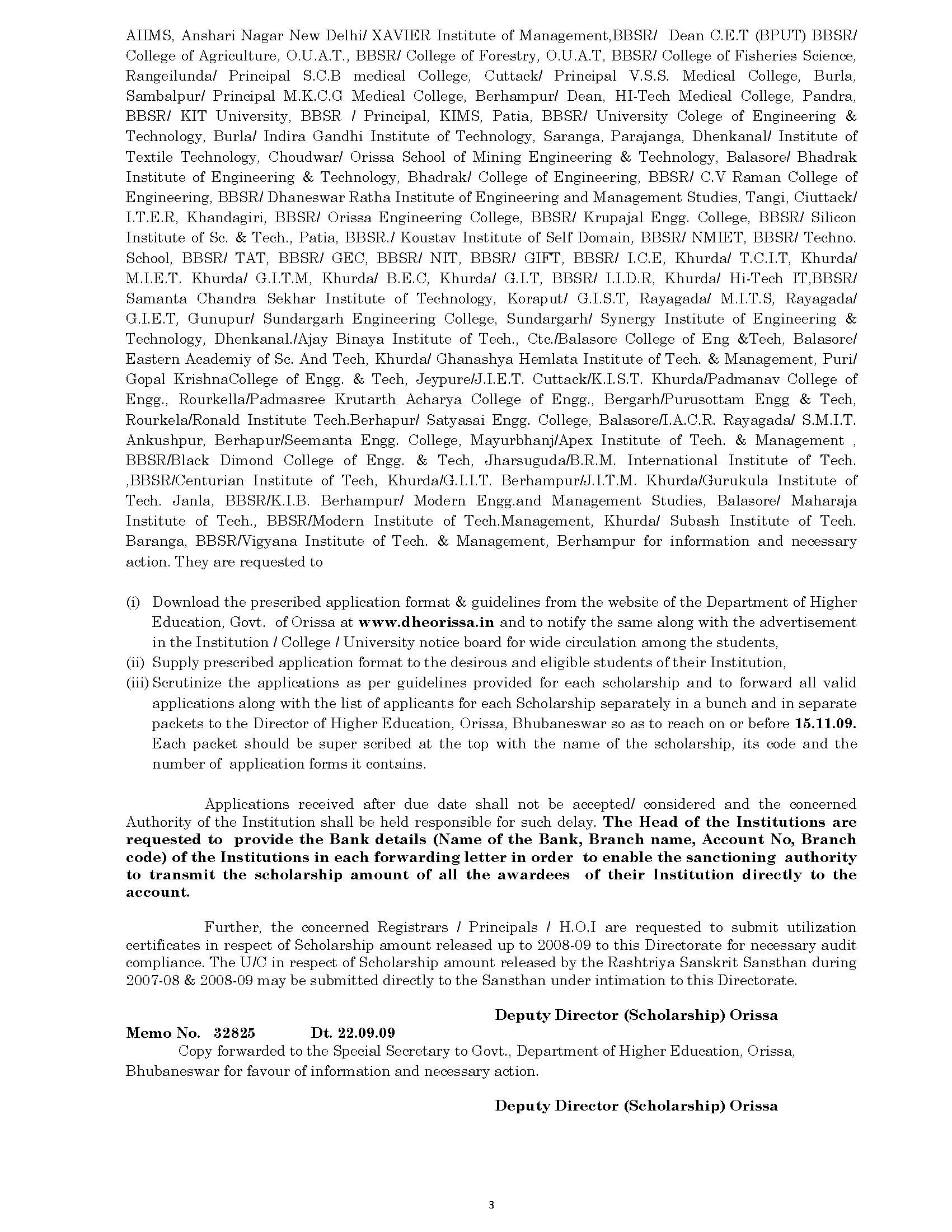
September 24th, 2009
Following is an excerpt from a report in Times of India.
… law minister Veerappa Moily has designed a grand plan to set up four regional institutes of excellence to equip lawyers and bring them on par with Indian IT professionals, who are known the world over for their competence.
Moily prefers to call these regional institutes of excellence simply "regional hubs" of legal education. "We have written to the Planning Commission for approval of the plan to set up these four institutes which will match standards of best law institutes anywhere in the world," he said, adding this move was spurred by one of the recommendations of the National Knowledge Commission.
September 24th, 2009
Pioneer reports on a letter written by Sanjib Karmee about establishing a central university in the Western part of Orissa. Following are some excerpts.
.. One such letter written to the Prime Minister, President and other top political leaders of the country including one to the Chief Minister of Orissa and members of Parliament, by Dr Sanjib Kumar Karmee of Bio-catalysis and Organic Chemistry group of the Delft University of Technology, The Netherlands, has made a fervent appeal to the powers that be to open a Central University in the Koshal region.
He has appreciated the efforts of Ministry of Human Resources and other Central Government ministries in the establishment of many centrally funded institutions in Orissa keeping the backwardness of the State in mind.
He has cited that the current Government of the State is adopting a capital centric approach, clustering Bhubaneswar with National Institute of Science Education and Research (NISER), Indian Institutes of Technology (IIT), All India Institute of Medical Sciences (AIIMS), and Railway Medical College.
The State Government has chosen only two such centrally funded institutes outside Bhubaneswar-Cuttack-Puri region of having a Central University at Koraput in south Orissa and a proposal to set-up the Indian Institute of Information Technology in Berhampur which is also in south Orissa.
Koshal region he writes is one of the most backward regions in Orissa, and has demanded the establishment of centrally funded institutes in Koshal region. At the same time he writes about the connectivity and amenities of the region which has infrastructural readiness to have a Central University, besides he says the region has two universities – Sambalpur University and VSS University of Technology – a Government Medical College, and a few private engineering colleges. Rourkela city which is close to Burla-Sambalpur-Jharsuguda area has a National Institute of Technology at Rourkela. On connectivity he writes there is a proposal by the Government of India to have an airport at Jharsuguda and further that Jharsuguda is well connected by rail to the various States in India. Burla-Sambalpur-Jharsuguda area is emerging as a central location for on going industrial activities in the region.
Since MHRD is very serious about increasing the GER, I think the 12th plan would include some more central universities (or at the worst case universities that are funded 50-50 by center and state). Also, as I mentioned earlier, many states have regions which have been left out of the national university (mostly went to the state capital or the 1st or 2nd most populated metro area of the bigger states; but all went to metro areas with a population of greater than 1 million; the obvious reason seems to be the vision behind these universities as stated in the first announcement as well as in the concept papers) and first central university distributions (many went to smaller places of the states), and they would like to have a central university/institution. This includes Nagpur in Maharastra, Kadapa in Andhra Pradesh, Durgapur/Asansol/Siliguri in West Bengal, Bhawanipatna/Jharsuguda/Rourkela in Orissa etc.
In Orissa, after CUO Koraput and national university in Bhubaneswar, the government should strongly consider a location in its Western part (and far from Bhubaneswar) for that. Among the possible locations, a sentimental favorite would be Bhawanipatna, as it has been reported that at one point the CM had assured the representatives from Kalahandi regarding locating the first central university there. Other good locations could be Rourkela (a bit in the corner though; but is a metro and has a sizable population and does not have a regular university; it does have NIT) and Jharsuguda (lots of industrial development happening here, not too far from Rourkela, but close to Sambalpur which has two universities; But Jharsuguda itself has nothing and is going to have an airport soon).
September 24th, 2009
The documents are at:
* http://www.education.nic.in/uhe/Universitiesconceptnote.pdf
* http://www.education.nic.in/uhe/Concept-BGP.pdf
Following are some excerpts from the first document:
Continue Reading September 22nd, 2009
Following is from Samaja.
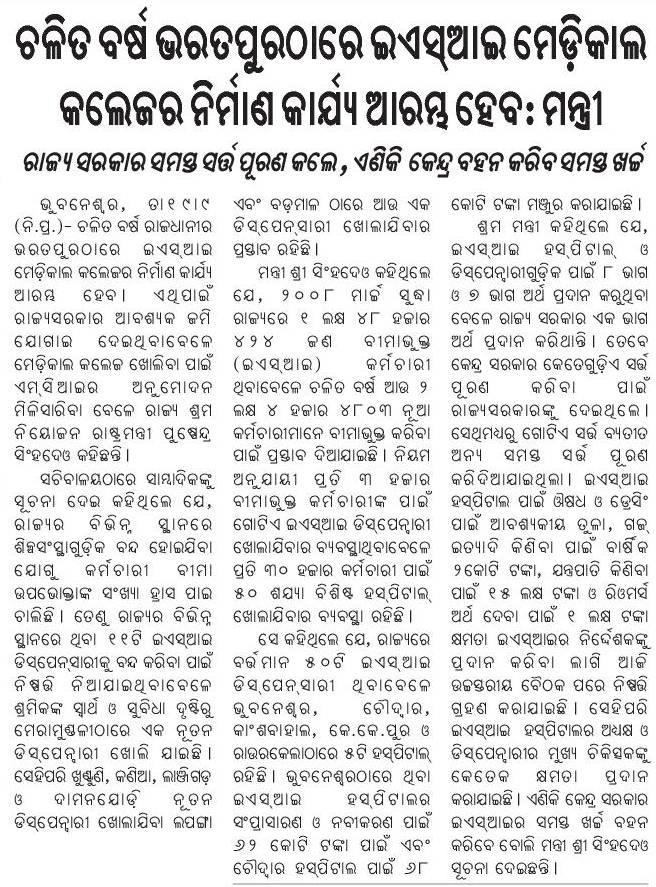
Sambada pinpoints the location as "near Institute of Mathematics & Applications."
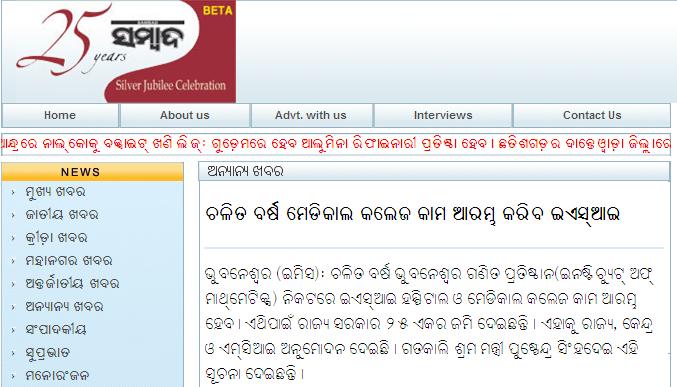
Overall the only new part here is the exact location of the land as when we started our campaign for ESIC medical college in Rourkela (in the end of August) we already knew that land had been allocated in Bhubaneswar.
So what do we do now?
Following are my suggestions.
- We need to continue pushing our case through emails, faxes, letter writing campaigns, ground level actions etc.
- We need to get the MLAs from the Rourkela area involved. They need to meet the CM and make the demands. Alternatively or in addition some civil society group needs to get an appointment with the CM and convey the demand for an ESI medical college in Rourkela.
- The MLAs around Rourkela and email/phone of some of them that I could find are:
- Rourkela – Sarada Nayak (BJD) sarada59@rediffmail.com
- Biramitrapur – George Tirkey (Independent) 0674-403599; 0661-643282
- Raghunathpali – Subrat Tarai (BJD)
- Rajgangpur – Gregory Minz (Congress)
- Bonai – Bhimsen Choudhury (BJP)
- Sundergarh – Jogesh Singh (Congress)
- Talsara – Dr. Prafulla Majhi (Congress)
- Kuchinda – Rajendra Chhatria (Congress)
The MP and ex-MP who can also meet the CM are:
- Hemanada Biswal – 09937350289
- Jual Oram – jualoram@rediffmail.com, jualoram@hotmail.com
- When these groups meet the CM they also need to have alternative proposals and an alternative set of demands. (This is in case the CM’s first response is that the land has been allotted and it can not be shifted at this stage.) Shifting of location once announced is extremely difficulty and a political hot potato. That is because if something is shifted from location A to B there will be people in A who will complain and no politician would want to do this. When A is Bhubaneswar it is even harder. (I also think that demanding shifting is not a good idea unless it is done by people of A. That is because it unnecessarily pits people of A against people of B. We on purpose never did it in case of NISER or IIT and as a result received political support from MPs and journalists of other states.)
- However, asking for an ESI medical college in Rourkela does not necessarily mean shifting the one announced in Bhubaneswar. The people meeting the CM, and at some point in our campaign, we should more forcefully point out that in other states in addition to the undergraduate medical college of ESI, 1 or more other locations will have post-graduate courses and in Karnataka there will be two ESI medical colleges. If we are able to convince this to our CM and if he demands to the center that ESI establish another medical college in Rourkela or at least PG teaching at its hospital in and around Rourkela then the chances of success are much high. But this need not be done now. We may continue with our current approach (with less badmouthing of Bhubaneswar) for some time. In this I suggest the approach and tone in here rather than the tone in the petition.
- Whether it is demanding something from the center or getting something for a region in Orissa, getting the CM on our side is most important. From past experience the best approach for getting something for a region in Orissa has been for a delegation of MLAs to meet the CM. Hence the list of MLAs above.
- With respect to fighting for Rourkela this should be just a beginning. The MLA delegation when they meet the CM should also ask the CM for
- a general state university and
- to push SAIL to establish a medical college and a engineering college, as it is doing in Bokaro. There are some technical hurdles but effort is on to overcome them. SAIL is up for its mine renewal in Orissa. See here and here. So this is the right time to do it. If SAIL Bokaro can make a medical college in Bokaro why can not SAIL Rourkela in Rourkela.
- These could be the alternative proposals that the delegation can propose to the CM.
September 20th, 2009
Following is from Dharitri:
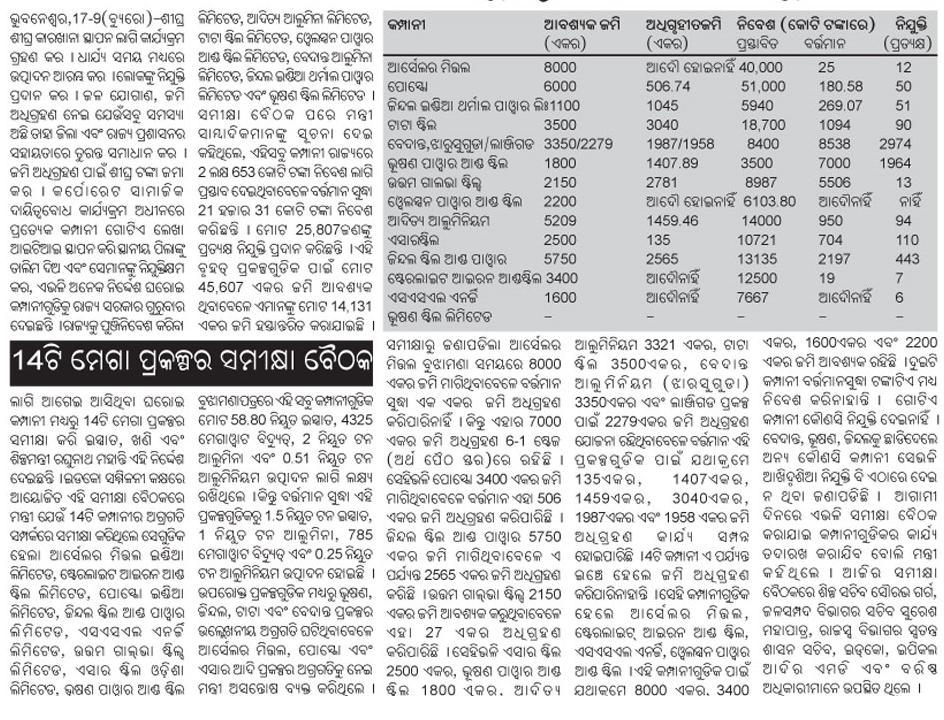
Today Pioneer reports on MP Bhakta Das’s demand to Vedanta with respect to Lanjigarh. Following is an excerpt from that report.
Das said the package should include direct employment of 5,000 locals in technical fields and indirect employment of 10,000 locals in non-technical fields, establishment of five technical colleges like medical, engineering, polytechnic and ITI and five central schools in the district.
Asked whether he would consider supporting extraction of bauxite in the Niyamgiri hill if VAL declares such a package, Das replied that a decision in this regard would be taken with consent of all citizens at a meeting where the industry would sign an agreement before the public.
Development of healthcare, roads, education and irrigation, connection of electricity to all villages, social activities, plantation, peripheral development and permanent income source for displaced people and tribals with lifetime free education to their children are also part of the package, he said. The industry would ensure that the flow of waters of rivers and streams in the Niyamgiri hill would not be affected. Consent of the tribals would have to be taken before handing over the hill, he said.
This is a constructive approach. I hope Vedanta agrees to it. (Although Vedanta’s Chairman is establishing a Rs 15,000 crore Vedanta University near Puri, with Rs 5000 crore of his own money, Vedanta should also pay attention to the localities where its industries are coming up and where its mining operations are located; in particular Lanjigarh and Jharsuguda; as those areas will bear the burnt of the pollution and environmental side effects and also many people there will be losing their lands.)
Following the above table the companies behind the other mega-projects should do the same. We list them here.
- Arcelor Mittal @ Keonjhar:
- POSCO @ Paradeep
- Jindal thermal @ Angul; Jindal Steel and Power @Kalinganagar
- Tata Steel, Kalinganagar
- Vedanta @ Jharsuguda and @ Lanjigarh; Sterlite Iron & Steel @Keonjhar
- Bhusan @ Kalinganagar
- Uttam Galva @Bistapal, Keonjhar
- Wellspun @Bhadrakh
- Aditya Aluminum @Rayagada @Sambalpur
- Essar Steel @Paradeep
- Essel Energy
To be continued …
September 19th, 2009
Following is from the VSSUT (formerly UCE Burla)’s alumni site http://www.alumniuce.com/messages.asp?id=264.
Dear Alumni,
After joining our alma-mater as its First Vice-Chancellor, Prof. Deb Kumar Tripathy has addressed the HODs, Deans, Faculty and Staff members of the University in the auditorium and shared his vision for the future. VSSUT Burla finally got a open minded and real visionary dynamic leader to excel in the field of technical education in the country. Here is a brief excerpts from his vision for VSSUT as delivered in his inaugural address.
***************************************************************************
(1) Make VSSUT Burla the No. 1 University in the state and a top ranked university in the country in future.
(2) Develop a new colourful big campus for the University with the support of Govt.
(3) Establish various centres of excellence to promote quality teaching and research in the university.
(4) Strengthen Industry-academia interaction and set up research laboratories at our university in collaboration with industries.
(5) Improve the residential life of students and develop more hostels with modern facilities.
(6) Recruit well qualified and potential talents as faculty of the university.
(7) Bring a dynamic change in the system so that every stackholder contributes and delivers their best for the betterment of the University.
******************************************************************************
Prof. Tripathy has a high aspiration from our 15,000 strong alumni to materialize his vision. He is soliciting high cooperation from our alumni association. He has requested the alumni to come forward with innovative ideas and constructive suggestions and join hands with him for the development of our alma-mater.
I request all the alumni members to congratulate our Vice-chancellor and put forward your valuable suggestions to help him build the VSSUT of our dream. His current e-mail id is as follows –
dkt@rtc.iitkgp.ernet.in
With best wishes and complements
Rakesh Mohanty
Secretary, VSSUT Alumni Association
September 18th, 2009
Following is from the PIB release at http://pib.nic.in/release/release.asp?relid=52692.
The Union Cabinet today approved setting up of new National Institutes of Technology (NITs). These new NITs will be established in Manipur; Meghalaya; Mizoram; Nagaland; Goa (which will also cater to UTs of Daman & Diu, Dadra & Nagar Haveli and Lakshdweep); Pudducherry (which will also cater to Andaman & Nicobar Islands); Sikkim; Delhi (which will also cater to Chandigarh) and Uttrakhand.
…
The new approved NITs are categprized under two Schemes, as follows:
(a) Scheme “A” consisting of proposed NITs at Manipur, Meghalaya, Mizoram, Nagaland, Goa, which will also cater to UTs of Daman & Diu, Dadra & Nagar Haveli and Lakshadweep, Pudducherry, which will cater to Andaman & Nicobar Islands also and Sikkim; and
(b) Scheme “B” consisting of approved NITs at Delhi (which will also cater to Chandigarh) and Uttrakahand.
Each of the NIT under scheme A will be established at a cost of Rs.250 crore while each of the NIT in scheme B will be set up at a cost of Rs.300 crore. Total project cost is Rs.2600 crore. During 11th Plan the expenditure will be of the order of Rs.540 crore and for the year 2009-2010 expenditure will be of the order of Rs.50 crore.
Main beneficiaries will be the students from the States/UTs which at present do not have NITs as seats will be earmarked for such students in these NITs along with seats earmarked to be filled on all India merit basis.
Presently there are 20 National Institutes of Technology (NITs), located at Agartala, Allahabad, Bhopal, Calicut, Durgapur, Hamirpur, Jaipur, Jalandhar, Jamshedpur, Kurukshetra, Nagpur, Patna, Raipur, Rourkela, Silchar, Srinagar, Surat, Surathkal, Tiruchirapalli and Warangal.
Comparing with an earlier PIB release http://pib.nic.in/release/release.asp?relid=41316&kwd=, it seems Arunachal Pradesh has been left out. One excuse may be that Arunachal Pradesh has NERIST, a nationally funded institute. I guess if people of Arunachal Pradesh complain, NERIST may get upgraded to an NIT.
Although initially it was mentioned that 10 new NITs will be established, the reason only 9 are now approved, is that the 10th slot perhaps went to the ABA Ghani Khan Choudhary Institute. This is mentioned in http://www.telegraphindia.com/1081217/jsp/nation/story_10263837.jsp.
September 17th, 2009
Following is an excerpt from a report in Business Standard.
… the government has decided to allow private funding in setting up some of the proposed 14 national universities, which would be of world class standards.
During his interaction with British Trade and Investment Minister Mervyn Davies, HRD Minister Kapil Sibal today said the government was in favour of setting up some of the 14 universities in Public-Private-Partnership (PPP) mode.
As per the government’s plan these universities would be "global centres of innovation". The HRD Ministry has already prepared a concept note on institutions proposed to be set up in the 11th Plan.
"Sibal told Davies that the government would seek PPP model for creation of some of these institutions. A few other may be set up under complete government funding," a ministry official said.
September 17th, 2009
The duration of the 11th plan is from 2007-2012. We are now in 2009 and very soon 2012 will be looming. My guess is that the planning commission may already be in its preparatory stage to start planning for 2012. Considering that one of the big focus of this government is to increase the GER (gross enrollment ratio) in higher education from 12.4% to 30% by 2020, the 12th plan will also pay significant attention to higher education. The national knowlede commission has also recommended that India have up to 50 national universities and 1500 universities. With that in mind, following is part of something that I wrote to Prof. Yash Pal (and copied to to Sam Pitroda) in June as a response to Prof. Yash Pal’s draft. (Prof Yash Pal replied back saying: "I thank you for your excellent and concerned suggestions. I have shared them with some of my colleagues. I am sure they would be taken up by some of them. Our report will be submitted in a week. Then will start another phase. Many of these will keep reverberating. Thank you again.")
ii) Regional Universities with 50-50 split between state and the center:
The Central government now has central universities and is proposing 14 national universities. In these universities the students are and will be from across the country and the universities will be funded 100% by the central government, except land being given by the state.
As you have noted some of the centrally managed universities and institutes (IITs, etc.) have a good structure and are doing the best.
As a way to transfer this first-hand to the states I propose the establishment of “Regional Universities” which are funded 50-50 by the state and the center and the students are 50-50 between the state and the rest of the country. This will be similar to the structure of the erstwhile “Regional Engineering Colleges (RECs)”, which have now been transformed to NITs. The original RECs were funded 50-50 by the state and center and had 50-50 students from the state and the rest of the country. The NITs are funded 100% by the center.
Eventually the regional universities may be funded 100% by the center. This idea has many benefits:
(a) The direct collaboration between a state and the center helps in the transfer of know-how of how to develop and manage a good university.
(b) It costs less for the center to create another 30-40 good universities, as the cost is shared 50-50.
(c) It helps develop additional knowledge centers in the states. (Most RECs were established in second rung cities in their respective states. REC/NIT in Orissa is in Rourkela, in Tamil Nadu it is in Trichy, in Maharashtra it is in Nagpur, in Karnataka it is in Surathkal, in West Bengal it is in Durgapur, etc.)
I think this is something feasible and should be pushed with the planning commission. Even with the new central universities and national universities many states have large metropolitan areas that did not get one and are in need of a good (at least partially) centrally funded institution and university. That gap can be filled with the above proposed regional universities. In Orissa possible location of such a regional university could be Rourkela or Jharsuguda.
The proposed national universities also had stringent criteria attached to them, which made it difficult to distribute them. For example, the PIB announcing them said:
As regards 14 Central Universities aiming at world class standards, it has been considered necessary that these are located in or near selected large cities which would automatically have the kind of connectivity and infrastructure which such universities would need.
Earlier reports mentioned prime locations being an important factor and gave an example criteria of what they meant by a prime location. They cited proximity to CSIR labs.
Like the erstwhile RECs, the proposed regional universities need not have such stringent conditions allowing them to be located in places like Durgapur, Kadapa, Rourkela, Jharsuguda, etc.
Another item that I had in my mail to Prof. Yash Pal, which should be pushed for the 12th plan is as follows:
(vi) University and local communities; National and regional libraries:
I think a good library should be an integral component of each of the universities. Currently the libraries in most universities and colleges in India are pathetic. While the libraries are improved it should also mandate that a big part of the library materials, should be available for browsing for common folks who are not necessarily enrolled in the university. In the US any one can walk into a university library, be it Berkeley (a state university) or Stanford (a private university). I am not sure if that is the case with respect to the universities and colleges in India.
While we are discussing libraries, like central universities and national universities, the Indian government should establish a national library in each state capital (100% funded by the central govt.), and a regional library (funded 50-50 by the state and the central govt.) in another city of a state. In 5-10 years there should be good libraries in each district and in 10-15 years in each block. (When I walk into the local library in the US, I envy not growing up in the US and recall having to beg my local book store in a cabin near my house in Bhubaneswar to lend me translations of the world literature book series. I could not afford to buy them. Nor did my school have them.)
A new item that I have mentioned once in a while and that can be genarlized for the 12th plan is to establish centrally funded rural technological institutes like SLIET (Sant Longowal Institute of Engineering and Technology) in Punjab and the recently proposed ABA Ghani Khan Choudhary Institute of Engineering and Technology in West Bengal, in each of the other major states of the country. In Orissa, Balangir and Kalahandi (Bhawanipatna) are good possible locations for this. (Orissa should aim for having a centrally funded institute in each of the undivided KBK+Kandhamal districts.) Although centrally funded, these institutes are different from the NITs. The PIB release in the context of ABA GKC IET says the following:
The Institution will offer courses in Engineering and Technology to cater to the various manpower requirements of the region, with special emphasis on courses relevant to the local population such as in food technology & sericulture.
Initially, the Institution would start with Certificate level courses leading to Diploma, Degree and Post-graduate levels later.
The total project outlay of the Institute will be around Rs. 97 crores.
Dear Readers: Please suggest your thoughts and ideas on the 12th plan. Even if your main interest is about your home town, think of a way to put it in national terms.
September 14th, 2009
September 19, 2009: Nice coverage in Khabara; From http://www.odiasamaja.org/wp-content/uploads/esi.jpg.

September 12-13, 2009: My friend Purna Mishra has written another nice email to the CM and MP Mr. Khuntia. Following is his letter.
Dear Esteemed Chief Minister Mr. Patnaik and Member of Parliament Mr. Khuntia,
From what I hear you both have been working at the opportunity to bring the ESI Medical College to Rourkela and get it funded at the earliest. I thank you for your vision and desire to make Orissa one of the leading states.
Even states with fewer employees in their ESI pool have already started the construction project (e.g., Kerala, Himachal Pradesh, etc.). Since the employees pay for their medical care, ESI is going to establish a medical college in Orissa as this is the ESI mandate.
In my last email, I mentioned a few benefits it would bring if this medical college is established in Rourkela. I found a much bigger benefit to Orissa if this medical college is established in Rourkela. The Phase-I construction cost alone is close to 500 crores. These are the cost of tenders over the last couple of years for the following ESI medical colleges:
1. Patna: 520 Crores
2. New Delhi: 617.87 Crores
3. Bangalore: 490 Crores
4. Dental Medical College, Mumbai: 158 Crores
The tenders for Kerala, Rajasthan, and Himachal Pradesh will be at least 450 crores each.
In this down economy where the central and state governments are giving incentives for private and public investments in local economy, let us see how an cash investment of 500+ crores in construction alone over a 2 year period will jump start the economy of north western Orissa. As most of the economists agree, the investment in construction sector brings the most help for local economy. Last time Rourkela received a serious investment was during the modernization drive where a capitalization of 5000 crores for expansion was made. But most of this investment were spent in acquiring
machineries and did not bring any direct investment to support the local economy. Even the second modernization scheme announced in 2005 for RSP was only 350 crores and again most of that investment was made to acquire
machineries. This will be for the first time in several decades that Rourkela and the north western Orissa would be receiving a investment of 500+ crores in local economy. Please do your best to bring this jumbo sized investment at your earliest. In this down economy this jumbo investment will jump start the local economic growth engine.
We need to build another city in Orissa that could complement Bhubaneswar as we make Orissa one of the leading states in India. The only other city that has this potential at this time is Rourkela.
The people of Orissa who will immensely benefit and will be eternally thankful for you standing up to the ESI babus and do what is right for Orissa.
With my best regards,
— Purna
September 11, 2009: Today’s Pioneer has a long article on this. (Thanks to Prashant Sahoo for the pointer.) Looks like a lot of organizations in Rourkela are now involved. But we should not rest easy until the demand is met. Following is an excerpt from that article.
It is learnt from sources that people from different walks of life have been sending e-mails to the Orissa Chief Minister requesting him to consider the relocation of the proposed ESIC Medical College. In the latest development, many Non-Resident Oriyas (NROs) are not only writing e-mails to the CM but also they are in regular touch with various civil society organisations of Rourkela to strengthen the drive into a people’s movement.
Many retired and working professors of NIT and other leading educational institutions of Rourkela like Prof Somanath Mishra, Prof SK Patel, Prof KC Patra, Prof DM Praharaj, Prof P Panda, Prof P Mallick and many others have come out openly to write letters to the CM along with pursuing others to join the movement. Even they have urged the people’s representatives of the district to take up the matter with the CM. Similarly, many civil society organisations like Disha, Envicare, Visstar, Ores, Cause, Sahayata, Basti Unnayan Samiti and many other groups have joined this drive.
Unlike others, many journalists like Pratap Padhee, Subrat Choudhury, Aurobinda Das, Sanjib Nayak, Mahendra Mishra, AP Biswal, KP Mohapatra and writers and columnists like Narayan Prasad Dash, Bhupen Mohapatra, Debendra Mohanty, KC Badjena, Bishnupriya Mohapatra and Arta Trana Mohapatra have also joined the drive. Similarly, many trade unions like RMS, SETU, RSS, SEAR, KISS, ILU, RWU, SMS and students’ organisations like SFI, AISF, ABVP, DSO and NSUI have also started campaign on their respective level. Even many student leaders have started signature campaign in their respective campuses.
September 10, 2009:
Dear all:
Following is an update on the efforts towards bringing ESIC Medical College to Rourkela.
- Lots of emails have been sent to the CM’s office.
- Among the media, Tathya.in and Pioneer have covered it.
- The email campaign is active in several groups. (myodisa, ornet, agamiorissa, nis-iiser etc.)
- An explicit yahoo group Rourkela Forum has been formed. http://groups.yahoo.com/group/rourkelaforum/
- An e-petition has been created http://www.petitiononline.com/ESI4RKLA/petition.html.
- MP Ram Khuntia has been contacted by phone and email.
- To avoid this topic to get buried under other newer topics in Orissalinks, I have put it in the scrolling bar as well as put it prominently in red in the right hand side bar towards the top. Clicking any of those links will bring it to this article and people can comment on it. Instead of creating new posts I will just update this post.
- Members of Myodisa are in the process of sending a memorandum to the CM.
- Orissa Society of the Americas is also in the process of sending a memorandum to the CM.
Next Steps:
- Continue emails, faxes, letters.
- Get more and more people to join the movement and join the Rourkela Forum yahoo group.
- Do some ground action in Rourkela.
- Contact MP Hemanada Biswal as soon as possible.
- Get more media coverage.
September 10th, 2009
Next Posts
Previous Posts








